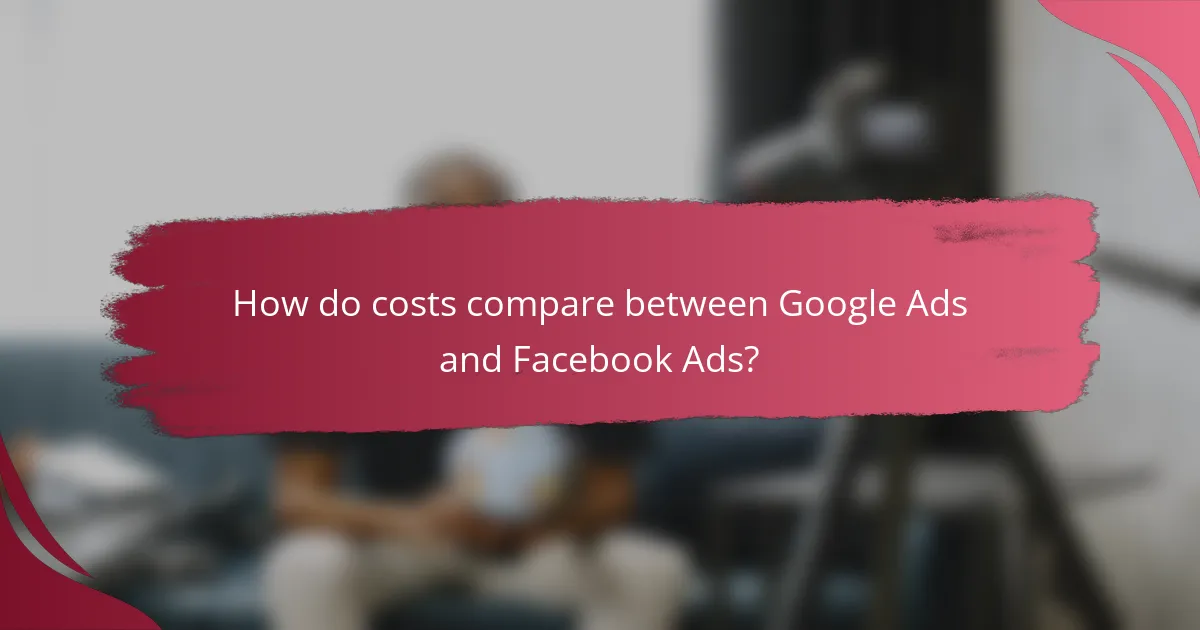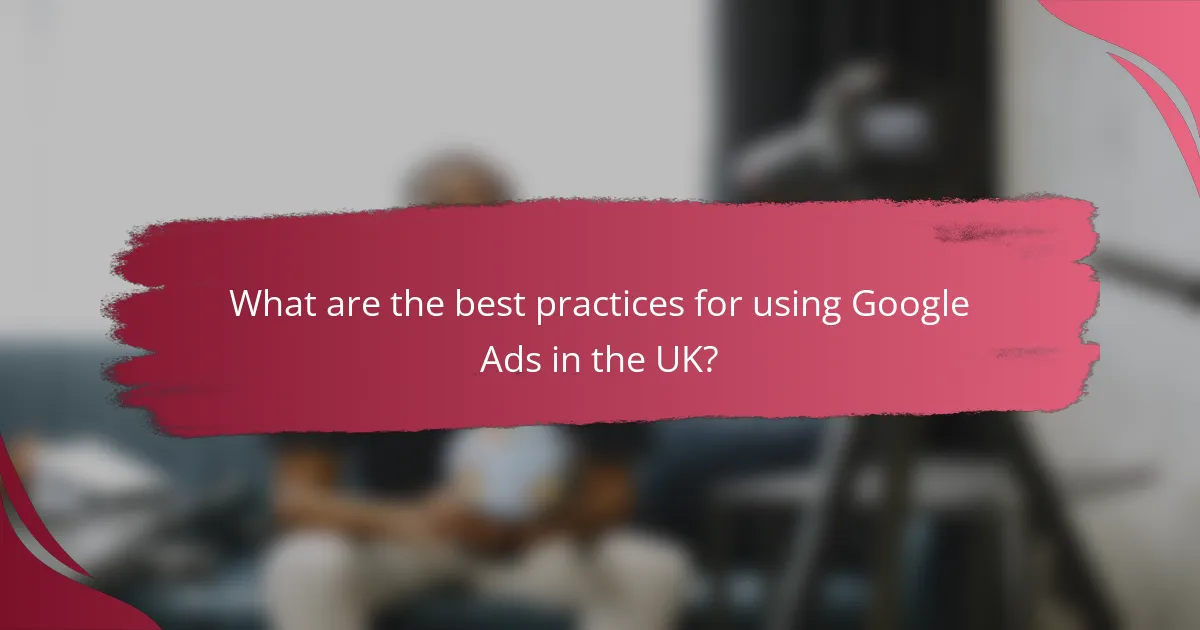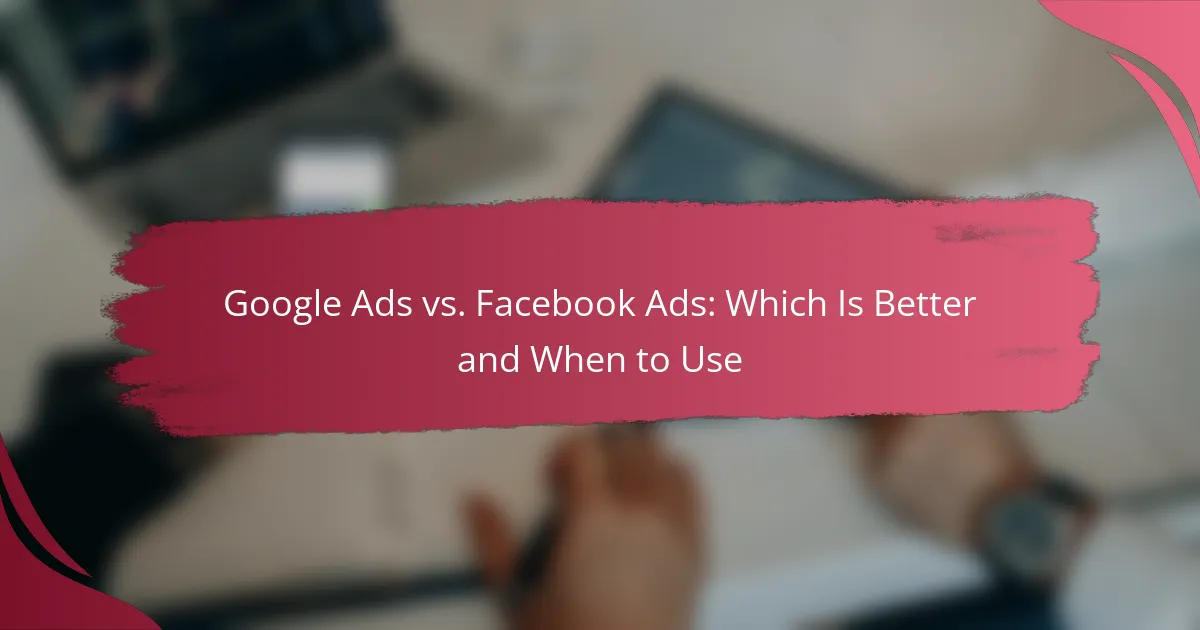When deciding between Google Ads and Facebook Ads, it’s essential to consider your marketing goals and audience. Google Ads is ideal for businesses seeking immediate visibility and high-intent leads, while Facebook Ads excels in building brand awareness and engaging with targeted demographics. Understanding the strengths of each platform can help you choose the right strategy for your advertising needs.

Which advertising platform is more effective for lead generation in the UK?
Google Ads is generally more effective for lead generation in the UK due to its high intent targeting capabilities. Users actively searching for specific products or services are more likely to convert, making Google Ads a strong choice for businesses focused on immediate results.
Google Ads offers high intent targeting
Google Ads allows advertisers to reach users who are actively searching for specific keywords related to their products or services. This high intent targeting means that ads are shown to individuals who are already interested, increasing the likelihood of conversion.
For example, a user searching for “plumber near me” is likely in need of plumbing services, making them a prime candidate for targeted ads. Businesses can benefit from this by using location-based keywords to attract local customers, which is crucial in the UK market.
Facebook Ads excels in audience engagement
Facebook Ads focuses on engaging users based on their interests, demographics, and behaviors rather than their immediate search intent. This platform is ideal for building brand awareness and nurturing leads over time through compelling visuals and storytelling.
For instance, a business selling eco-friendly products can target users interested in sustainability, even if they aren’t actively searching for those products. This approach can create a more engaged audience, which may lead to conversions later on.

When should I use Google Ads?
Google Ads is best used when you need immediate visibility and want to capture users actively searching for specific products or services. This platform excels in targeting search intent, making it ideal for businesses looking to drive quick traffic and conversions.
For immediate visibility and search intent
Google Ads provides immediate visibility on search engine results pages (SERPs), allowing businesses to appear at the top when users search for relevant terms. This is particularly beneficial for time-sensitive promotions or new product launches, where being first can significantly impact traffic and sales.
Consider using Google Ads when you have a clear understanding of your target audience’s search behavior. For example, if you sell seasonal products, launching an ad campaign just before peak shopping times can maximize your reach and engagement.
When targeting specific keywords
Google Ads allows you to target specific keywords that potential customers are using, making it effective for capturing high-intent traffic. By selecting relevant keywords, you can ensure your ads are shown to users who are actively looking for what you offer.
To optimize your campaigns, conduct thorough keyword research to identify terms with a good balance of search volume and competition. Tools like Google Keyword Planner can help you find keywords that align with your business goals. Avoid overly broad keywords, as they may lead to irrelevant clicks and wasted budget.

When should I use Facebook Ads?
Facebook Ads are particularly effective when your goal is to build brand awareness or engage with a social audience. They excel in targeting specific user demographics and interests, making them a powerful tool for reaching potential customers where they spend their time online.
For brand awareness and social engagement
Using Facebook Ads for brand awareness allows businesses to reach a broad audience and create a presence on social media. The platform’s visual nature supports engaging content, such as videos and images, which can capture attention quickly.
Consider running campaigns that highlight your brand’s story or values. For instance, a local café might share posts about its sourcing practices or community involvement, fostering a connection with potential customers. Aim for a frequency that keeps your brand top-of-mind without overwhelming users.
When targeting demographics and interests
Facebook’s robust targeting options enable advertisers to reach specific demographics and interests effectively. You can filter audiences based on age, location, interests, and behaviors, allowing for tailored messaging that resonates with each segment.
For example, if you sell outdoor gear, you can target users interested in hiking, camping, or fitness. This precision can lead to higher engagement rates and conversions. However, be cautious of narrowing your audience too much, as it may limit your reach and potential customer base.

What are the key differences between Google Ads and Facebook Ads?
Google Ads and Facebook Ads differ primarily in their targeting methods and user intent. Google Ads targets users actively searching for specific information, while Facebook Ads focuses on users based on their interests and behaviors.
Google Ads targets search queries
Google Ads operates on a pay-per-click model, allowing businesses to display ads to users who enter specific keywords into the search engine. This means that ads are shown to users who are already interested in a product or service, making it a powerful tool for capturing demand.
When using Google Ads, consider the importance of keyword research. Effective keywords can lead to higher click-through rates and conversions. Aim for a mix of broad and long-tail keywords to reach a wider audience while still targeting specific queries.
Facebook Ads focuses on user behavior
Facebook Ads leverage user data to target individuals based on their interests, demographics, and online behavior. This allows advertisers to create highly tailored ads that resonate with specific audience segments, even if those users are not actively searching for a product.
To maximize the effectiveness of Facebook Ads, utilize audience insights and custom audiences. Experiment with different ad formats, such as carousel ads or video ads, to engage users effectively. Keep in mind that ad performance may vary, so regularly monitor and adjust your campaigns for optimal results.

How do costs compare between Google Ads and Facebook Ads?
The costs associated with Google Ads and Facebook Ads can vary significantly based on factors like targeting, competition, and ad format. Generally, Google Ads tends to have higher costs per click (CPC), while Facebook Ads can offer more cost-effective options for reaching a larger audience.
Google Ads typically has higher CPC
Google Ads often results in higher CPC rates compared to Facebook Ads, primarily due to the competitive nature of search-based advertising. Advertisers bid on keywords, and in high-demand sectors, CPC can reach several dollars, sometimes even exceeding $10 for competitive keywords.
When using Google Ads, it’s crucial to conduct thorough keyword research to identify cost-effective terms that still drive relevant traffic. Consider long-tail keywords, which may have lower competition and CPC, while still attracting targeted users.
Facebook Ads can be more cost-effective for reach
Facebook Ads typically provide a more economical way to achieve broad reach, especially for brand awareness campaigns. The cost per thousand impressions (CPM) can be significantly lower than CPC on Google, making it easier to engage a wider audience at a fraction of the cost.
Utilizing Facebook’s detailed targeting options allows advertisers to hone in on specific demographics, interests, and behaviors, maximizing the effectiveness of their budget. Experimenting with different ad formats, such as video or carousel ads, can also enhance engagement without drastically increasing costs.

What are the best practices for using Google Ads in the UK?
To effectively use Google Ads in the UK, focus on local targeting, optimizing ad copy, and monitoring performance. These practices can significantly enhance your ad visibility and conversion rates.
Utilize local keywords for targeting
Incorporating local keywords is crucial for targeting UK audiences effectively. Use terms that reflect regional language and preferences, such as “near me” or specific city names, to increase relevance.
Consider using tools like Google Keyword Planner to identify popular local search terms. This can help you tailor your campaigns to meet the specific needs of your target audience.
Optimize ad copy for conversions
Creating compelling ad copy is essential for driving conversions. Focus on clear, concise messaging that highlights your unique selling points and includes a strong call to action.
Test different variations of your ad copy to see which resonates best with your audience. A/B testing can help you identify the most effective headlines and descriptions, leading to improved click-through rates and conversions.

What are the best practices for using Facebook Ads in the UK?
To effectively use Facebook Ads in the UK, focus on creating visually appealing content and utilizing audience insights for precise targeting. These practices can significantly enhance engagement and conversion rates.
Use engaging visuals and videos
Engaging visuals and videos are crucial for capturing attention on Facebook. High-quality images, infographics, and short videos can increase user interaction and improve ad performance. Aim for visuals that resonate with your target audience and reflect your brand identity.
Consider using video ads that tell a story or demonstrate your product in action. Research shows that video content can lead to higher engagement rates compared to static images. Keep videos concise, ideally under 30 seconds, to maintain viewer interest.
Leverage audience insights for targeting
Utilizing audience insights allows you to tailor your Facebook Ads to specific demographics, interests, and behaviors. Facebook’s Audience Insights tool provides valuable data on your target market, helping you refine your ad strategy.
Segment your audience based on factors such as age, location, and interests to create personalized ads. For instance, if you are targeting young adults in urban areas of the UK, adjust your messaging and visuals to appeal to their preferences. Regularly analyze ad performance data to optimize your targeting and improve ROI.
